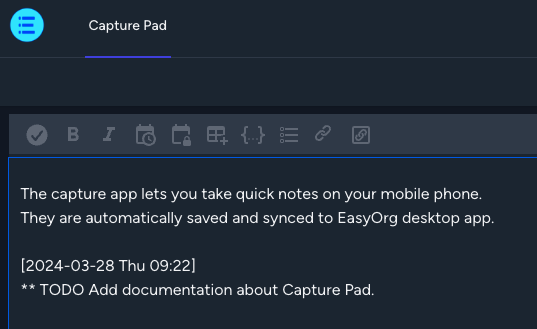Syncing
If you want to access your notes and todo-lists from several computers and your mobile phone then there are several tools you can use. As EasyOrg is based on plain text files there is great flexibility in how to handle synchronization between devices.
One of the most flexible and transparent tools is Syncthing. You can set it up to sync specific files and/or folders and once done they will be kept in sync if you update the files on your computer or on your mobile. Syncthing does not store anything in the cloud.
In this documentation we will not go through how to set it up as it is well explained on Syncthings website.
Other great alternatives are Dropbox, pCloud and iCloud. They make it easy to sync files and folders between several computers and phones. In addition your files get stored in the cloud.
Capture Notes and Tasks - Capture App

EasyOrg lets you sync notes between mobile phones and the desktop app by using a companion app. It's a web based app that runs in the browser (eg. Chrome, Firefox on Android or iOS as well as on any desktop browser). It provides a little editor where you can enter your quick notes and tasks and it will be immediately synced to our server and then further on to your EasyOrg desktop app.
You can go to easyorg.app and create an account using the email you have used with your license purchase. Once logged in you go to the Profile page and paste in your license key. When this is done you can create an API token, copy it and then paste it into the EasyOrg desktop app within Settings.
Now you can write notes on your phone and access them directly within EasyOrg without having to setup any specific additional software.
You can also edit the text from the EasyOrg desktop and it will be reflected on the web app. For example if you want to remove the tasks you have already moved over to another org-file.
The notes data on our server are encrypted using AES-256-CBC. In addition, when you delete the data from the web app or the EasyOrg app, it will be deleted from the server as well. The same if you would delete your web app account, then all your data are completely deleted an cannot be recovered.

A notification dot is shown on the button which opens the capture pad if there are additions or changes to your capture note. This way you get a reminder to check the latest stuff you have entered while you where away.
File versioning
Another great benefit of using text files is that you can get versioning support. You can go back and forth in time to refer to older versions of your Org files.
EasyOrg supports this out of the box as an integrated solution. Go to 'File > File History' in the menu. You will see all saved version of the current file including a diff view. The diff view compares the old file with the current version in the editor. You can also see a full view of the old file. And you can copy parts or all of the file if you like. See more about this feature on the EasyOrg Features page.
If you prefer to handle versioning outside of EasyOrg that's of course also possible as the data are stored as text files on your disk.
Syncthing, Dropbox and pCloud all support file versioning in case you store your files on a disk handled by them. Another obvious tool for file versioning is Git.
Backup
Thanks to using text files as storage medium it's easy to setup a backup to run every day and store it on another disk or server. You probably already have a backup solution in place and if your Org files are stored within a directory that is backed up, you already have you EasyOrg files backed up!
Alternatives
Other alternatives for sync could be using GitHub, WebDAV, NextCloud, NAS or other cloud storage services.